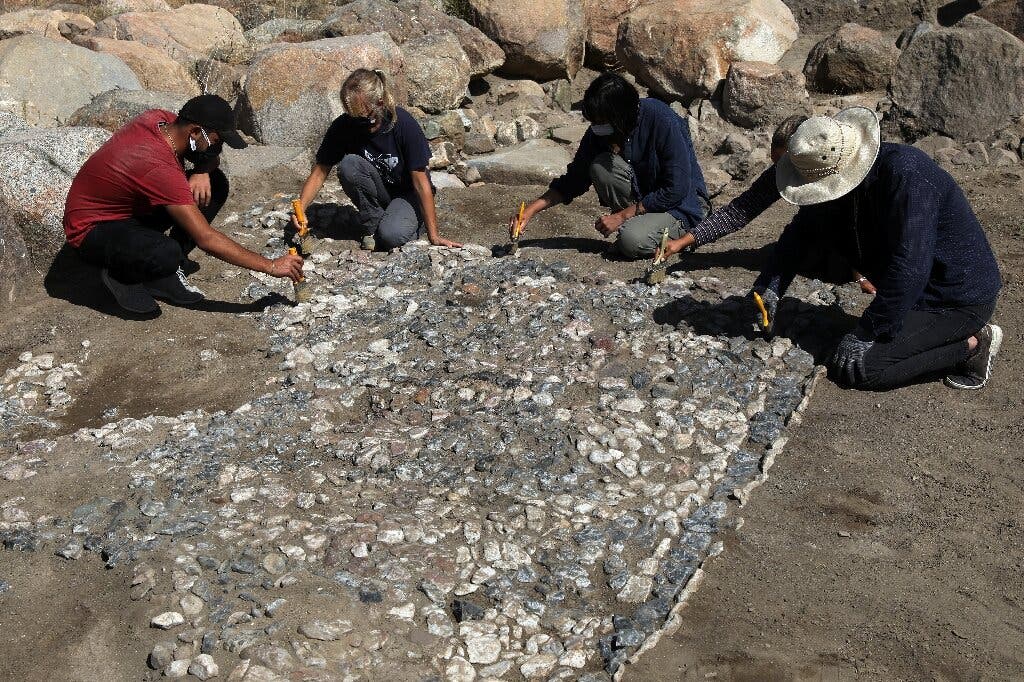Archeologists working in central Turkey have uncovered what may be the “ancestor” of all Mediterranean mosaics. This piece dates back over three and a half centuries, hailing from the Bronze Age. While impressive in and of itself, researchers hope that its discovery can help us better understand the history of the quite mysterious Hittite people.

The mosaic was unearthed at a site some three hours’ driving distance from Turkey’s capital city of Ankara, according to local news outlets. This site is known as Uşaklı Höyük, and some 3,500 years ago, it was the site of a Hittite temple. On its grounds, archeologists have uncovered a mosaic consisting of over 3,000 unpainted stones, whose natural shades of beige, red, and black were used to create various curves and triangle shapes. This piece of art predates the oldest known mosaics — from ancient Greece — by around 700 years.
Researchers working at the site believe that this element was meant as a stepping stone of some sort and wasn’t necessarily put together with the intention of being a mosaic. However, given its age, this may very well be the “ancestor” of all mosaics, with the ideas used in its construction later replicated throughout the Mediterranean.
A true original
“It is the ancestor of the classical period of mosaics that are obviously more sophisticated. This is a sort of first attempt to do it,” says Anacleto D’Agostino, excavation director of Uşaklı Höyük.
“For the first time, people felt the necessity to produce some geometric patterns and to do something different from a simple pavement. Maybe we are dealing with a genius? Maybe not. It was maybe a man who said ‘build me a floor’ and he decided to do something weird?”
The site was first located in 2018, and teams of Turkish and Italian archaeologists have been working here ever since. The site sits in the shadow of the Kerkenes mountain on the grounds of an ancient temple which, the team explains, was very likely dedicated to Teshub. This was a storm god of the Hittites, roughly equivalent to Zeus in ancient Greek mythology.
D’Agostino says that while the exact use of this proto-mosaic is unknown, it is possible that it was made to resemble the Kerkenes mountain, likely to serve a ritual purpose. Ceramic fragments and the remains of a palace have also been found at the site, hinting at its original size, inhabitation levels, and overall importance.
Based on these, the team is quite confident that Uşaklı Höyük is the lost city Zippalanda, an important settlement and place of worship for Teshub, mentioned frequently in Hittite tablets. The Hittites employed cuneiform writing and left behind a relative wealth of texts on clay tablets.
“Researchers agree that Uşaklı Höyük is one of two most likely sites. With the discovery of the palace remains alongside the luxurious ceramics and glassware, the likelihood has increased,” D’Agostino says.
Still, until solid, verifiable proof is found — such as a tablet or inscription mentioning the site’s original name — this remains pure conjecture. Despite the extent of the ruins at Uşaklı Höyük, precious few artifacts have been uncovered at the site.
By the way, these are not the same Hittites that most people are familiar with — those mentioned in the bible. The Hittites who made this mosaic lived during the late Bronze Age and were vying for supremacy in the region with other great civilizations of the era: the New Kingdom of Egypt, the Middle Assyrian Empire, and the Mittani Empire.
These Hittites were pretty advanced for their time, being some of the first to use, and perhaps even the inventors of, iron smelting from meteoric iron. Even so, like many other empires and states during the time, the Hittite empire crumbled during the Bronze Age collapse, and the Hittites broke into small kingdoms scattered through today’s Syria, Lebanon, and the Levant. What caused this collapse of virtually every major organized state at the end of the Bronze Age is still a matter of much debate and little evidence; among the leading theories is that either invading ‘sea peoples’ or shifts in climate caused widespread social unrest.
“I don’t know if we can find a connection between ancient Hittites and people living here now. Centuries and millennia have passed, and people moved from one place to another,” D’Agostino says. “But I would like to imagine that some sort of spiritual connection exists.”
In honor of this possible connection, the archeologists working at Uşaklı Höyük have also been recreating dishes from recipes found on clay tablets at the site, trying to stay as faithful to the techniques and materials used in antiquity. The team explains that they also reproduced Hittite ceramics using local clay for the purpose. So far, they’ve sampled baked dates and bread cooked using these dishes, says Valentina Orsi, co-director of the excavation, which were “very good”.









